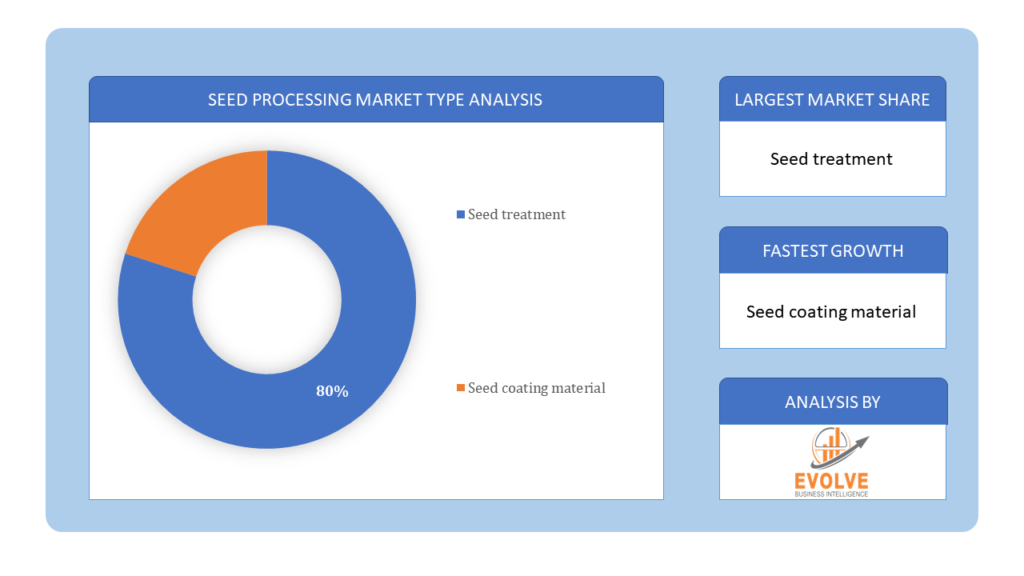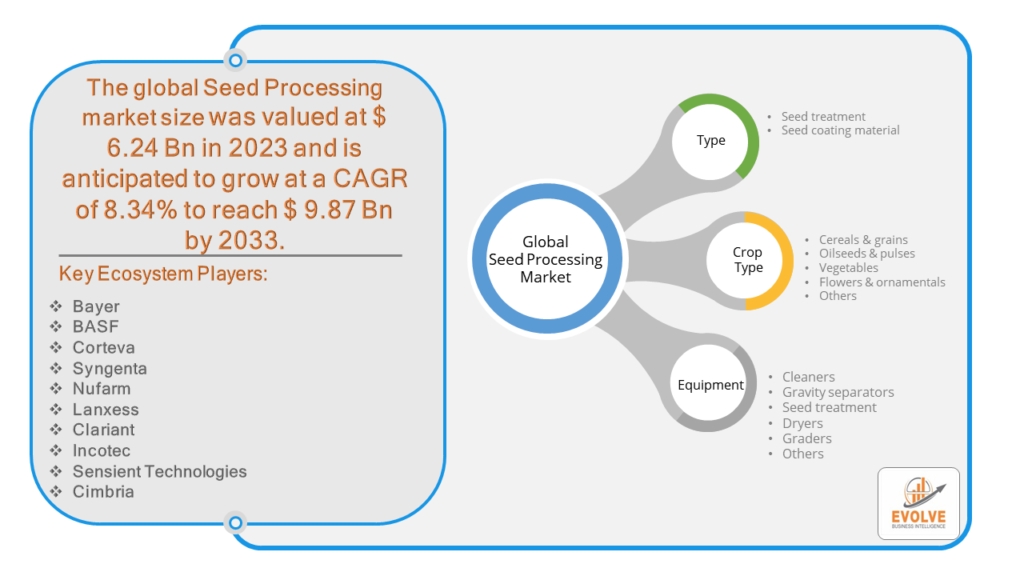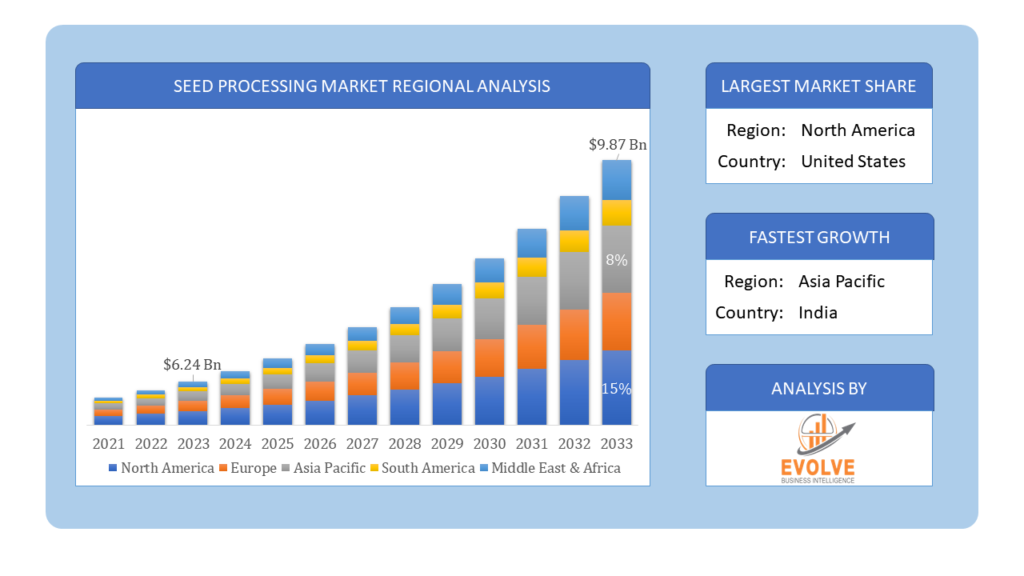Seed processing Market Overview
The Seed processing Market Size is expected to reach USD 9.87 Billion by 2033. The Seed processing industry size accounted for USD 6.24 Billion in 2023 and is expected to expand at a compound annual growth rate (CAGR) of 8.34% from 2023 to 2033. The seed processing market involves preparing harvested seeds for marketing to farmers through processes like drying, threshing, and treatment. It aims to clean seeds, enhance quality, and ensure viability for planting. Key aspects include seed treatment and coating materials, catering to various crop types like vegetables, pulses, and cereals. Major players in the market include Bayer AG, BASF SE, Syngenta AG, Nufarm Ltd., and Clariant AG. The market is witnessing significant growth driven by factors like global population increase, agricultural modernization, and enhanced seed quality standards, with a projected market size of $13.11 billion in 2024 and expected growth to $19.64 billion by 2028.
Global Seed processing Market Synopsis
The Seed processing market experienced a positive impact due to the COVID-19 pandemic. Due to supply chain disruptions brought on by the COVID-19 epidemic, there are either shortages or decreased demand in the market for seed processing. Spending by consumers and businesses has decreased significantly as a result of the travel restrictions and social distancing measures, and this trend is expected to persist for some time. The epidemic has altered end-user trends and tastes, leading manufacturers, developers, and service providers to implement several measures in an attempt to stabilize their businesses.
Global Seed processing Market Dynamics
The major factors that have impacted the growth of Seed processing are as follows:
Drivers:
⮚ Technological Advancements
Advances in biotechnology, genetic engineering, and seed treatment technologies have revolutionized the seed processing industry. These technologies enable the development of genetically modified seeds, hybrid seeds, and treated seeds with enhanced characteristics such as improved yield, pest resistance, and drought tolerance.
Restraint:
- Climate Change Risks and Uncertainties
Climate change poses risks and uncertainties for agricultural productivity, affecting seed performance and market demand. Erratic weather patterns, extreme temperatures, water scarcity, and the spread of pests and diseases can disrupt seed production cycles, reduce crop yields, and increase production costs, impacting the profitability and stability of the seed processing market.
Opportunity:
⮚ Expansion of Specialty Crop Markets
Growing consumer demand for specialty crops, including fruits, vegetables, and niche crops, presents lucrative opportunities for seed processing companies. By focusing on breeding and processing specialty crop seeds with superior flavor, nutritional value, and shelf-life, companies can tap into premium market segments and capture higher margins compared to commodity crops.
Seed processing Market Segment Overview
By Type
 Based on the Type, the market is segmented based on Seed treatment and Seed coating material. Seed treatment dominates the seed processing market due to its efficacy in protecting seeds from diseases and pests, enhancing germination rates, and improving crop yields. Additionally, it offers cost-effective and environmentally sustainable solutions compared to conventional methods.
Based on the Type, the market is segmented based on Seed treatment and Seed coating material. Seed treatment dominates the seed processing market due to its efficacy in protecting seeds from diseases and pests, enhancing germination rates, and improving crop yields. Additionally, it offers cost-effective and environmentally sustainable solutions compared to conventional methods.
By Crop Type
Based on the Crop Type, the market has been divided into Cereals & grains, Oilseeds & pulses, Vegetables, Flowers & ornamentals, Others. Cereals segment is expected to hold the largest share in the market owing to the government’s strong focus on food security from developing markets.
By Equipment
Based on Equipment, the market has been divided into Cleaners, Gravity separators, Seed treatment, Dryers, Graders and Others. The seed processing equipment segment includes various machines used to prepare harvested seeds for marketing. These machines are designed to dry, clean, size-grade, treat, and package seeds. The air screen cleaner is a crucial machine in every cleaning plant, using screens and aspiration for two separations. Other equipment includes cleaner-cum-graders, which clean and grade dried seeds, and extraction, threshing, enhancement, drying, cleaning, treatment, and transport equipment
Global Seed processing Market Regional Analysis
Based on region, the market has been divided into North America, Europe, Asia-Pacific, the Middle East & Africa, and Latin America. The area of Asia-Pacific is anticipated to dominate the market for the usage of Seed processing, followed by those in North America and Europe.
 Seed processing Asia-Pacific Market
Seed processing Asia-Pacific Market
Asia-Pacific dominates the Seed processing market due to several factors. The market for seeds in the Asia-Pacific region will be the largest due to the region’s growing urbanization and agricultural expansion. The adoption of hybrids and increasing rates of seed replacement in vital crops including vegetables, rice, and maize will spur market expansion in this area.
Seed processing North America Market
The Asia-Pacific region has been witnessing remarkable growth in recent years. From 2023 to 2032, the North American Seeds Market is anticipated to develop at the quickest CAGR. This is caused by the rising demand for agricultural products, which is further supported by the government’s supportive policies, extensive R&D, and reasonably priced seed. In addition, the Asia-Pacific region’s fastest-growing market for seeds was Canada, while the United States had the biggest market share.
Competitive Landscape
The competitive landscape includes key players (tier 1, tier 2, and local) having a presence across the globe. Companies such as Bayer, BASF, CORTEVA, Syngenta, and Nufarm are some of the leading players in the global Seed processing Industry. These players have adopted partnership, acquisition, expansion, and new product development, among others as their key strategies.
Key Market Players:
- Bayer
- BASF
- CORTEVA
- Syngenta
- Nufarm
- Lanxess
- Clariant
- Incotec
- Sensient Technologies
Key development:
July 2022: Corteva Agriscience, BASF, and MS Technologies signed Agreement to develop next-generation Enlist E3 soybeans with the nematode-resistant soybean (NRS) trait for farmers in the United States and Canada.
June 2022: A new range of tropicalized lettuce is introduced, which is named Arunas RZ. This is expected to boost the market share of the company.
May 2022: Syngenta Canada has introduced new Pelta seed pelleting technology for canola, which helps in optimizing seed size and uniformity, enabling improved singulation planter performance.
Scope of the Report
Global Seed processing Market, by Type
- Seed treatment
- Seed coating material
Global Seed processing Market, by Crop Type
- Cereals & grains
- Oilseeds & pulses
- Vegetables
- Flowers & ornamentals
- Others
Global Seed processing Market, by Equipment
- Cleaners
- Gravity separators
- Seed treatment
- Dryers
- Graders
- Others
Global Seed processing Market, by Region
- North America
- US
- Canada
- Mexico
- Europe
- UK
- Germany
- France
- Italy
- Spain
- Benelux
- Nordic
- Rest of Europe
- Asia Pacific
- China
- Japan
- South Korea
- Indonesia
- Austalia
- Malaysia
- India
- Rest of Asia Pacific
- South America
- Brazil
- Argentina
- Rest of South America
- Middle East & Africa
- Saudi Arabia
- UAE
- Egypt
- South Africa
- Rest of Middle East & Africa
| Parameters | Indicators |
|---|---|
| Market Size | 2033: $9.87 Billion |
| CAGR | 8.34% CAGR (2023-2033) |
| Base year | 2022 |
| Forecast Period | 2023-2033 |
| Historical Data | 2021 |
| Report Coverage | Revenue Forecast, Competitive Landscape, Growth Factors, and Trends |
| Key Segmentations | Type, Crop Type, Equipment |
| Geographies Covered | North America, Europe, Asia-Pacific, Latin America, Middle East, Africa |
| Key Vendors | Bayer, BASF, CORTEVA, Syngenta, Nufarm, Lanxess, Clariant, Incotec, Sensient Technologies, Cimbria. |
| Key Market Opportunities | • Increasing demand for healthy products Demand for organic products |
| Key Market Drivers | • Increasing use of oilseeds Increasing replacement of seeds |
REPORT CONTENT BRIEF:
- High-level analysis of the current and future Seed processing Industry trends and opportunities
- Detailed analysis of current market drivers, restraining factors, and opportunities analysis in the future
- Historical market size for the year 2021, and forecast from 2023 to 2033
- Seed processing market share analysis for each segment
- Competitor analysis with a comprehensive insight into its product segment, financial strength, and strategies adopted.
- Identifies key strategies adopted by the key players including new product development, mergers and acquisitions, joint ventures, collaborations, and partnerships.
- To identify and understand the various factors involved in the global Seed processing market affected by the pandemic
- To provide year-on-year growth from 2022 to 2033
- To provide short-term, long-term, and overall CAGR comparison from 2022 to 2033.
- Provide Total Addressable Market (TAM) for the Global Seed processing Market.






